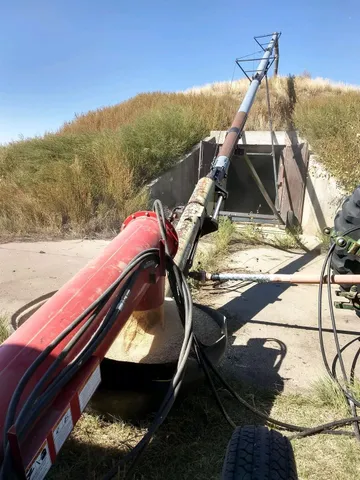SIDNEY, NE – With the Nebraska Panhandle finally seeing seasonable weather, including 90-degree days, it’s time for millet harvest for Narjes Land and Livestock north of Sidney Sidney.
Like many farmers across the state, the Narjes family had their run-in with mother nature. 23 inches of rain on their farm this summer delayed everything from harvest to planting. They usually average 12-15 inches of rain.
However, the moisture hasn’t been able to reach their stored wheat and millet, thanks to a unique way of protecting their grain.
The Sioux Army Depot was the only U.S. Army Ammunition Depot in Nebraska during World War II, the Korean War and the Vietnam War. It’s mission was to receive, store and issue all types of ammunition (from small arms to 10,000-pound bombs) and general supplies.
The depot occupied 19,771 acres and included 801 ammunition storage igloos. When the depot was deactivated on June 30, 1967, they sold the land and igloos to several area farmers and a local coop.
The igloo’s constant temperature and ability to stay dry made them great for storing grain, such as wheat and millet, according to Tyson Narjes. Corn and soybeans don’t work as well, because they tend to sweat and have humidity coming off them.
“The biggest problem you have with the igloo is getting grain out of them is not an easy task,” Narjes says. “Typically, we hire the local coop here. They come out with a grain evacuator and they’ll suck most of it out. They also bring out a small skid-steer and they’ll push the grain to the door and then suck it out. It’s not an easy process to get it out, but once you put it in, it’ll stay there and it’ll stay good forever, as long as you check on it every now and again.”
Tyson farms with his wife, Regina; his older brother, Ryan, and his wife, Laura; and his parents, Gary and Susan.
Narjes says his family has been using the igloos for storage since he was a kid. He remembers going with his grandpa and dad to check on grain when he was six-years-old and meeting a few unexpected visitors.
“My grandpa had actually opened the door to those igloos and there’s a basket inside the door,” Narjes said. “There were two or three of the biggest bull snakes I’ve ever seen in my life. It was just unbelievable that it happened that time and to this day I don’t forget that. Every time I open that door I look for those darn snakes.”
While snakes are not supposed to be in the storage units, grain is. Adding wheat and millet to the unit is much more simpler than removing it. The Narjes’ use a regular auger to drop the grain through an eight-inch vent at the top of the igloo.
90° in September means proso millet harvest. Using WWII military bunkers for storage pic.twitter.com/cJ14GmhuF3
— Tyson Narjes (@narj_15) September 17, 2019
They’ll “store-and-ignore” the grain until prices double or triple, which happens every seven to 10 years. The last time prices soared was in 2012-2013 and a couple of local farmers forgot they had millet stored in the igloos.
“There was a couple old farmers that somehow forget they had igloos full of millet,” Narjes said. “The rumor was there was a couple millet igloos that were 20-years-old. Kind of interesting that it sat there for that long, and they pulled it out and it look just as good as the day they put it in. They’re just a great storage option, especially for millet.”
Narjes is a 2007 graduate from Sidney High School and graduated with his Diversified Agriculture degree from the University of Nebraska-Lincoln in 2010. He and his wife have two kids.

















